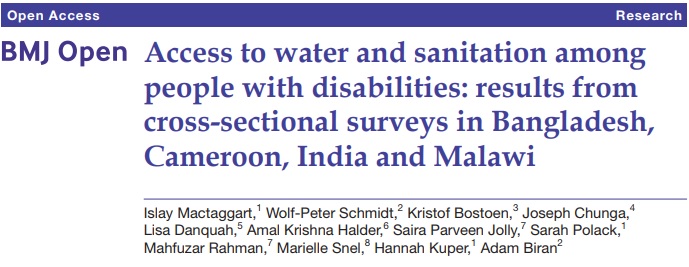Access to water and sanitation among people with disabilities
A multi country study was conducted in Bangladesh, Cameroon, India and Malawi on access to water and sanitation among people with disabilities. The findings state that In Bangladesh-2, households including a person with a disability were more likely to share facilities with other households.
Abstract
Objectives To assess access to adequate water, sanitation and hygiene (WASH) among people with disabilities at the household and individual level. Design Cross-sectional surveys. Setting Data were included from five district-level or regional-level surveys: two in Bangladesh (Bangladesh-1, Bangladesh-2), and one each in Cameroon, Malawi and India. Participants 99 252 participants were sampled across
the datasets (range: 3567–75 767), including 2494 with disabilities (93–1374). Outcome Prevalence of access to WASH at household and individual level. Data analysis Age/sex disaggregated disability prevalence estimates were calculated accounting for survey design. The Unicef/WHO Joint Monitoring Programme definitions were used to classify facilities as improved/unimproved. Multivariable logistic regression was undertaken to compare between households with/ without a person with a disability, and to identify predictors of access among people with disabilities. Results There were no differences in access to improved sanitation or water sources between households with/ without members with disabilities across the datasets. In Bangladesh-2, households including a person with a disability were more likely to share facilities with other households (OR 1.3, 95% CI 1.1 to 1.5). Households with people with disabilities were more likely to spend >30min (round- trip) collecting drinking water than households without in both Cameroon (OR 1.8, 95% CI 1.0 to 3.4) and India (OR 2.3, 95% CI 1.2 to 4.7). Within households, people with disabilities reported difficulties collecting water themselves (23%–80%unable to) and accessing the same sanitation facilities as other household members, particularly without coming into contact with faeces (up to 47% in Bangladesh-2). These difficulties were most marked for people with more severe impairments. Conclusions People with disabilities may not have poorer access to WASH at the household level, but may have poorer quality of access within their households. Further programmatic work is needed to ensure WASH facilities are inclusive of people with disabilities.


